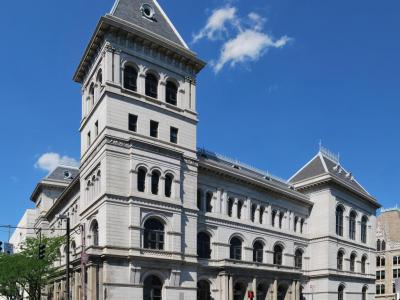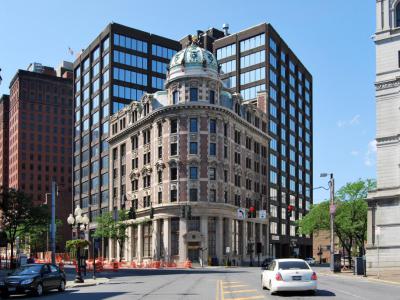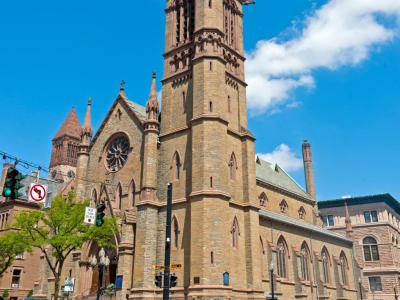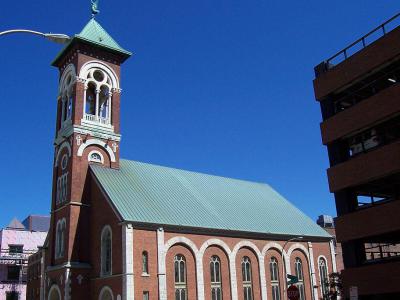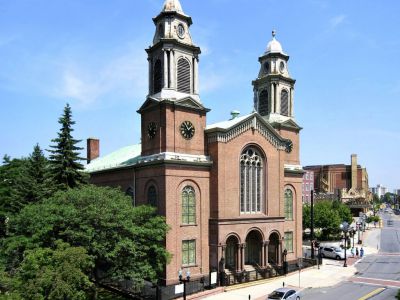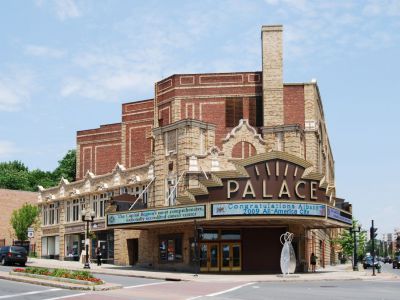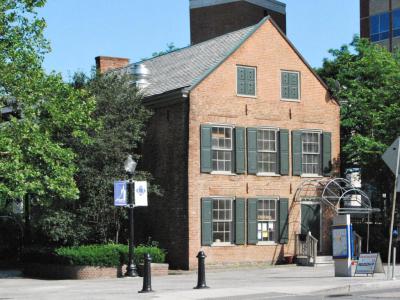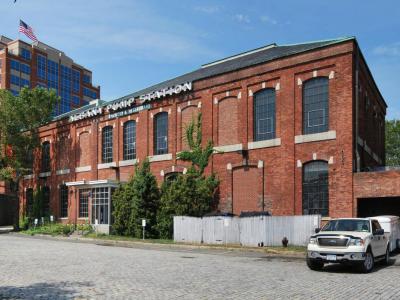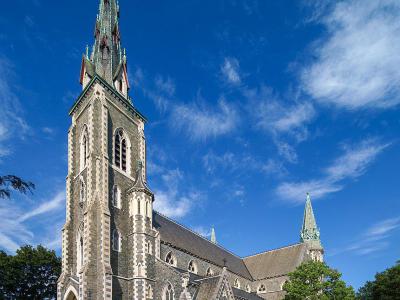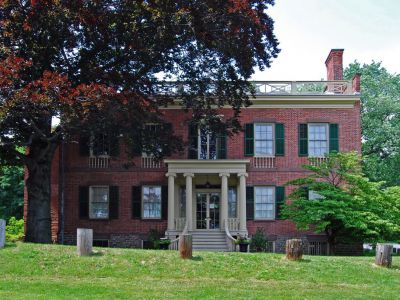Albany's Historical Buildings Tour (Self Guided), Albany
Albany is steeped in history and architectural splendor, featuring a varied collection of buildings that mirror its diverse and layered past. The city’s architecture ranges from majestic government edifices to prominent educational establishments, highlighting Albany’s role as a key political and cultural center.
More than just functional structures, these buildings are lasting emblems of Albany’s historical and cultural identity, encouraging both locals and tourists to explore and appreciate its architectural treasures. Here’s a glimpse into some of Albany's most significant historical buildings.
SUNY Plaza, originally the Delaware & Hudson Railroad Building, serves as a striking example of the Gothic Revival style, now repurposed as the administrative offices of the State University of New York.
The Old Post Office, built in the late 19th century in the Romanesque style, stands out for its robust and detailed stonework, symbolizing the era's federal presence in Albany.
Albany Trust Company Building and Saint Peter's Episcopal Church both showcase elaborate architectural trends from different eras, with the church being noted for its impressive Neo-Gothic design, complete with stained glass windows and a detailed façade.
Saint Mary’s Church, another gem, reflects the Italian Romanesque Revival influence and serves as a beacon of Albany's religious heritage.
The YMCA Building and Kenmore Hotel are exemplary depictions of late 19th-century architecture, having housed many notable guests and events through the decades.
Albany Union Station, once a bustling hub of rail activity, echoes the Beaux-Arts style, which was prevalent in the early 1900s.
Palace Theatre, known for its ornate interior and atmospheric style, has been an entertainment cornerstone since the 1930s.
Quackenbush House, one of Albany's oldest structures, offers a glimpse into the Dutch colonial period, while the nearby Albany Pump Station, now a popular brewery, highlights industrial architecture.
Lastly, Ten Broeck Mansion, originally built in the Federal and then renovated in the Greek-revival style, adds to the narrative of Albany’s aristocratic past with its elegant design and preserved interiors.
Collectively, these and other buildings featured in this self-guided tour enrich our understanding of Albany’s architectural evolution. If you find yourself intrigued by the stories these structures could tell, consider visiting Albany to see these historical landmarks firsthand. Walking through the city's streets can offer a tangible connection to the past and an enriching cultural experience.
More than just functional structures, these buildings are lasting emblems of Albany’s historical and cultural identity, encouraging both locals and tourists to explore and appreciate its architectural treasures. Here’s a glimpse into some of Albany's most significant historical buildings.
SUNY Plaza, originally the Delaware & Hudson Railroad Building, serves as a striking example of the Gothic Revival style, now repurposed as the administrative offices of the State University of New York.
The Old Post Office, built in the late 19th century in the Romanesque style, stands out for its robust and detailed stonework, symbolizing the era's federal presence in Albany.
Albany Trust Company Building and Saint Peter's Episcopal Church both showcase elaborate architectural trends from different eras, with the church being noted for its impressive Neo-Gothic design, complete with stained glass windows and a detailed façade.
Saint Mary’s Church, another gem, reflects the Italian Romanesque Revival influence and serves as a beacon of Albany's religious heritage.
The YMCA Building and Kenmore Hotel are exemplary depictions of late 19th-century architecture, having housed many notable guests and events through the decades.
Albany Union Station, once a bustling hub of rail activity, echoes the Beaux-Arts style, which was prevalent in the early 1900s.
Palace Theatre, known for its ornate interior and atmospheric style, has been an entertainment cornerstone since the 1930s.
Quackenbush House, one of Albany's oldest structures, offers a glimpse into the Dutch colonial period, while the nearby Albany Pump Station, now a popular brewery, highlights industrial architecture.
Lastly, Ten Broeck Mansion, originally built in the Federal and then renovated in the Greek-revival style, adds to the narrative of Albany’s aristocratic past with its elegant design and preserved interiors.
Collectively, these and other buildings featured in this self-guided tour enrich our understanding of Albany’s architectural evolution. If you find yourself intrigued by the stories these structures could tell, consider visiting Albany to see these historical landmarks firsthand. Walking through the city's streets can offer a tangible connection to the past and an enriching cultural experience.
How it works: Download the app "GPSmyCity: Walks in 1K+ Cities" from Apple App Store or Google Play Store to your mobile phone or tablet. The app turns your mobile device into a personal tour guide and its built-in GPS navigation functions guide you from one tour stop to next. The app works offline, so no data plan is needed when traveling abroad.
Albany's Historical Buildings Tour Map
Guide Name: Albany's Historical Buildings Tour
Guide Location: USA » Albany (See other walking tours in Albany)
Guide Type: Self-guided Walking Tour (Sightseeing)
# of Attractions: 14
Tour Duration: 2 Hour(s)
Travel Distance: 2.6 Km or 1.6 Miles
Author: Maia
Sight(s) Featured in This Guide:
Guide Location: USA » Albany (See other walking tours in Albany)
Guide Type: Self-guided Walking Tour (Sightseeing)
# of Attractions: 14
Tour Duration: 2 Hour(s)
Travel Distance: 2.6 Km or 1.6 Miles
Author: Maia
Sight(s) Featured in This Guide:
- SUNY Plaza
- Old Post Office
- Albany Trust Company Building
- St. Peter's Episcopal Church
- St. Mary's Church
- YMCA Building
- Kenmore Hotel
- Albany Union Station
- First Church in Albany (Reformed)
- Palace Theatre
- Quackenbush House
- Albany Pump Station
- St. Joseph Church
- Ten Broeck Mansion
1) SUNY Plaza
SUNY Plaza, locally referred to as "The Castle" or "D&H Plaza," was originally constructed for the Delaware & Hudson Railroad Company. Its striking design, characterized by Gothic architectural elements, includes a central tower that rises thirteen stories and is crowned by an 8-foot-tall working weathervane modeled after Henry Hudson's ship, the Half Moon.
The building serves as the central administrative headquarters for the State University of New York (SUNY) system, underscoring its significance in the state's educational framework. Listed on the National Register of Historic Places in 1972 as the Delaware and Hudson Railroad Company Building, it also contributes to the Downtown Albany Historic District, designated in 1980. The structure spans several sections, with its north to south expanse comprising at least six distinct parts, including a former undecorated warehouse and a square tower with four corner turrets connected diagonally to the central tower.
Architectural details of the building reflect Albany's Dutch heritage, despite its primary Gothic style. The gables feature coats of arms from notable Dutch families, including Albany's first mayor, Pieter Schuyler. Additionally, inscriptions of names and dates of prominent printers, such as William Caxton, on the Albany Evening Journal building facade, blend historical elements into the overall design. This integration of Gothic and Dutch motifs not only highlights the building's aesthetic appeal but also its cultural and historical significance in Albany.
The building serves as the central administrative headquarters for the State University of New York (SUNY) system, underscoring its significance in the state's educational framework. Listed on the National Register of Historic Places in 1972 as the Delaware and Hudson Railroad Company Building, it also contributes to the Downtown Albany Historic District, designated in 1980. The structure spans several sections, with its north to south expanse comprising at least six distinct parts, including a former undecorated warehouse and a square tower with four corner turrets connected diagonally to the central tower.
Architectural details of the building reflect Albany's Dutch heritage, despite its primary Gothic style. The gables feature coats of arms from notable Dutch families, including Albany's first mayor, Pieter Schuyler. Additionally, inscriptions of names and dates of prominent printers, such as William Caxton, on the Albany Evening Journal building facade, blend historical elements into the overall design. This integration of Gothic and Dutch motifs not only highlights the building's aesthetic appeal but also its cultural and historical significance in Albany.
2) Old Post Office
The Old Post Office, also known as the United States Government Building, was constructed between 1879 and 1883. Initially, plans for a larger Gothic Revival structure were proposed two decades before its actual construction. However, due to extended time and the high costs associated with land acquisition, these plans were scaled back. Instead, a more modest yet elegant building in the Italian Renaissance Revival style was erected.
The Old Post Office served as Albany's main postal facility until 1972 when postal operations were relocated to larger premises. Despite this move, the building continued to house various federal government offices for a few more years. In 1977, the building became part of SUNY Plaza, the central administrative headquarters of the State University of New York (SUNY). Since then, it has been repurposed for use by SUNY’s central administration.
The architectural significance of the Old Post Office was recognized when it was listed on the National Register of Historic Places in 1972. Additionally, it contributes to the historical fabric of the Downtown Albany Historic District, which was added to the National Register in 1980.
The Old Post Office served as Albany's main postal facility until 1972 when postal operations were relocated to larger premises. Despite this move, the building continued to house various federal government offices for a few more years. In 1977, the building became part of SUNY Plaza, the central administrative headquarters of the State University of New York (SUNY). Since then, it has been repurposed for use by SUNY’s central administration.
The architectural significance of the Old Post Office was recognized when it was listed on the National Register of Historic Places in 1972. Additionally, it contributes to the historical fabric of the Downtown Albany Historic District, which was added to the National Register in 1980.
3) Albany Trust Company Building
The Albany Trust Company Building is a distinguished historic commercial building designed by Marcus T. Reynolds in the Renaissance Revival style. Constructed in 1904, the building currently houses the main offices of the Research Foundation for the State University of New York. Its architectural significance and historical value were recognized when it was listed on the National Register of Historic Places in 1973 under the name First Trust Company Building. Additionally, it is a contributing property to the Downtown Albany Historic District.
The site at State Street and Broadway has been historically significant since the 1830s, originally featuring a rounded building. In 1902, the Albany Trust Company commissioned Marcus T. Reynolds, a prominent Albany architect, to design a new headquarters. Reynolds retained the distinctive rounded design, emphasizing it by placing the main entrance at the corner and crowning the building with a dome shape. This unique architectural feature highlights the building's prominence and provides a visually striking focal point.
Inside, the Albany Trust Company Building boasts a circular banking floor, which enhances the elegance and functionality of the space. The building's design not only serves its commercial purposes but also stands as a testament to early 20th-century architectural innovation. Extensions were later added along both State Street and Broadway, further expanding its footprint while maintaining its stylistic coherence.
The site at State Street and Broadway has been historically significant since the 1830s, originally featuring a rounded building. In 1902, the Albany Trust Company commissioned Marcus T. Reynolds, a prominent Albany architect, to design a new headquarters. Reynolds retained the distinctive rounded design, emphasizing it by placing the main entrance at the corner and crowning the building with a dome shape. This unique architectural feature highlights the building's prominence and provides a visually striking focal point.
Inside, the Albany Trust Company Building boasts a circular banking floor, which enhances the elegance and functionality of the space. The building's design not only serves its commercial purposes but also stands as a testament to early 20th-century architectural innovation. Extensions were later added along both State Street and Broadway, further expanding its footprint while maintaining its stylistic coherence.
4) St. Peter's Episcopal Church
Saint Peter's Episcopal Church, has a storied history, with three successive buildings marking its presence. The first structure, completed in 1717 under Reverend Thomas Barclay, was the first Anglican church west of the Hudson River and north of New York City. This initial building, a significant milestone for the Anglican community in the region, unfortunately, suffered damage from a fire in 1731. A second church was then built, opening in 1803, and serving the congregation until the construction of the current edifice.
The third and present Saint Peter's Church, completed in 1860, was designed by the renowned architects Richard Upjohn and his son Richard M. Upjohn. This Gothic Revival masterpiece is constructed with Schenectady bluestone and New Jersey sandstone trim. One of its most distinctive features is the 20-foot square tower at the southeast corner, crowned by a narrow 180-foot octagonal tower that houses a spiral staircase.
The church's exterior is adorned with French Gothic decorations, creating an impressive and historic facade. The interior, finished in rich black walnut, features original stained glass windows by Clayton & Bell and sculptures by Louis Saint-Gaudens.
One unique aspect of Saint Peter's Episcopal Church is the interment of Lord Howe's remains beneath its vestibule, making it the only site in the United States where a British Lord is buried. This historical connection further enhances the church's significance and adds a layer of depth to its already rich history.
The third and present Saint Peter's Church, completed in 1860, was designed by the renowned architects Richard Upjohn and his son Richard M. Upjohn. This Gothic Revival masterpiece is constructed with Schenectady bluestone and New Jersey sandstone trim. One of its most distinctive features is the 20-foot square tower at the southeast corner, crowned by a narrow 180-foot octagonal tower that houses a spiral staircase.
The church's exterior is adorned with French Gothic decorations, creating an impressive and historic facade. The interior, finished in rich black walnut, features original stained glass windows by Clayton & Bell and sculptures by Louis Saint-Gaudens.
One unique aspect of Saint Peter's Episcopal Church is the interment of Lord Howe's remains beneath its vestibule, making it the only site in the United States where a British Lord is buried. This historical connection further enhances the church's significance and adds a layer of depth to its already rich history.
5) St. Mary's Church
Saint Mary's Church holds a significant place in the history of Catholic missionary work in the New World. As the oldest Catholic congregation in upstate New York, Saint Mary's has been a cornerstone of the community since the late 18th century. The church has seen three different buildings over its history to accommodate its growing congregation, largely due to waves of immigration. The current structure, completed in 1867, stands as a testament to this rich heritage. Recognized for its historical and architectural significance, Saint Mary's was listed on the National Register of Historic Places in 1977 and is a contributing property to the Downtown Albany Historic District.
Architecturally, Saint Mary's is a striking example of the Italian Romanesque Revival style. The two-and-a-half-story, three-by-six-bay brick building features marble trim on a cut bluestone foundation, which becomes more visible towards the rear due to the land's slope. The west façade is dominated by the central bay, which projects slightly to form the base of the 175-foot bell tower, crowned with an angel of judgment. The main block of the church is topped by a steeply pitched gabled roof, and a five-section semicircular apse extends from the rear, enhancing its grandeur.
Inside, Saint Mary's contrasts its Romanesque exterior with a richly decorated interior that combines Mannerist and French Gothic styles. This blend creates an atmosphere of intricate beauty and spiritual reverence. The church was the first in Albany to be wired for electric lighting in 1894, showcasing its pioneering spirit. In 1912, the original stained glass windows were replaced, and today, these windows depict various saints and religious figures, adding to the church's serene and reflective ambiance.
Architecturally, Saint Mary's is a striking example of the Italian Romanesque Revival style. The two-and-a-half-story, three-by-six-bay brick building features marble trim on a cut bluestone foundation, which becomes more visible towards the rear due to the land's slope. The west façade is dominated by the central bay, which projects slightly to form the base of the 175-foot bell tower, crowned with an angel of judgment. The main block of the church is topped by a steeply pitched gabled roof, and a five-section semicircular apse extends from the rear, enhancing its grandeur.
Inside, Saint Mary's contrasts its Romanesque exterior with a richly decorated interior that combines Mannerist and French Gothic styles. This blend creates an atmosphere of intricate beauty and spiritual reverence. The church was the first in Albany to be wired for electric lighting in 1894, showcasing its pioneering spirit. In 1912, the original stained glass windows were replaced, and today, these windows depict various saints and religious figures, adding to the church's serene and reflective ambiance.
6) YMCA Building
The former Young Men's Christian Association (YMCA) Building is a notable example of Romanesque Revival architecture. Constructed in the 1880s, it was designed by local architects Fuller & Wheeler, who successfully adapted the Romanesque Revival style to fit the densely developed urban site. The building features characteristic elements of the style, including robust masonry and detailed stonework, which contribute to its historical and architectural significance. In the 1920s, an adjacent structure was annexed, and a rear addition was built to accommodate the growing needs of the YMCA.
Upon its completion in 1886, the YMCA Building boasted several pioneering amenities. It housed the first gymnasium in upstate New York and one of the earliest indoor swimming pools in the country. This made the building a significant recreational and social hub in Albany. Remarkably, it also played a role in the early history of basketball, hosting the first game played outside of Springfield College, where the sport was invented.
The building's Romanesque Revival design is considered a prime example of the architectural style in a commercial urban setting. Its robust construction and decorative details stand out amidst the surrounding neighborhood, which is densely packed with similarly vintage and scaled brick commercial buildings. The YMCA Building's architectural and historical importance was recognized in 1978 when it was listed on the National Register of Historic Places. It was further acknowledged in 1980 as a contributing property to the Downtown Albany Historic District.
Upon its completion in 1886, the YMCA Building boasted several pioneering amenities. It housed the first gymnasium in upstate New York and one of the earliest indoor swimming pools in the country. This made the building a significant recreational and social hub in Albany. Remarkably, it also played a role in the early history of basketball, hosting the first game played outside of Springfield College, where the sport was invented.
The building's Romanesque Revival design is considered a prime example of the architectural style in a commercial urban setting. Its robust construction and decorative details stand out amidst the surrounding neighborhood, which is densely packed with similarly vintage and scaled brick commercial buildings. The YMCA Building's architectural and historical importance was recognized in 1978 when it was listed on the National Register of Historic Places. It was further acknowledged in 1980 as a contributing property to the Downtown Albany Historic District.
7) Kenmore Hotel
The Kenmore Hotel was built in 1878 by Adam Blake, an African-American entrepreneur who was a prominent and respected figure in the community. Born on April 6, 1830, Blake was the son of a slave owned by General Stephen Van Rensselaer III. Before constructing the Kenmore, Blake owned Congress Hall, a hotel located at the corner of Washington Avenue and Park Street, which was demolished to make way for the New York State Capitol building.
The Kenmore Hotel was built on the corner of North Pearl Street and Columbia Street and quickly established itself as a premier establishment in Albany. Following Adam Blake's death in 1881, his widow, Catherine, managed the hotel until 1887, continuing his legacy of excellence and community service. The Kenmore's significance extends beyond its architectural beauty, as it represents a notable chapter in the history of African-American entrepreneurship and resilience.
In 1986, the Kenmore Hotel underwent significant renovations to transform it into an office building, preserving its historical charm while adapting it for modern use. More recently, in 2019, developers revitalized the historic Rain-Bo Room within the Kenmore, a space renowned for its opulent staircase and grand 25-foot ceilings. This renovation included the addition of an upper-level mezzanine, and the space was rechristened the Kenmore Ballroom, now available for weddings, events, and receptions. T
The Kenmore Hotel was built on the corner of North Pearl Street and Columbia Street and quickly established itself as a premier establishment in Albany. Following Adam Blake's death in 1881, his widow, Catherine, managed the hotel until 1887, continuing his legacy of excellence and community service. The Kenmore's significance extends beyond its architectural beauty, as it represents a notable chapter in the history of African-American entrepreneurship and resilience.
In 1986, the Kenmore Hotel underwent significant renovations to transform it into an office building, preserving its historical charm while adapting it for modern use. More recently, in 2019, developers revitalized the historic Rain-Bo Room within the Kenmore, a space renowned for its opulent staircase and grand 25-foot ceilings. This renovation included the addition of an upper-level mezzanine, and the space was rechristened the Kenmore Ballroom, now available for weddings, events, and receptions. T
8) Albany Union Station
Albany Union Station, built between 1899 and 1900, is a historic landmark. Initially constructed to serve as the city's primary railroad station, Union Station played a pivotal role in the transportation network of the early 20th century. Its construction was managed by Norcross Brothers, renowned contractors of the time, ensuring the station was built to the highest standards of the period. The building's significance is underscored by its listing on the National Register of Historic Places in 1971.
During its peak, Union Station was a bustling hub of activity, reflecting Albany's importance as a transportation nexus. In 1900, the station received 96 trains per day, a number that surged to 121 daily trains during World War II, underscoring its crucial role in facilitating the movement of people and goods. The station primarily served the New York Central Railroad's passenger trains but also hosted services from the Delaware & Hudson Railway, making it a key junction for various rail lines.
Union Station continued to operate as the Capital District's main railroad station until December 1968. Following the decline in passenger rail service, the building transitioned to a new role and now houses bank offices. Despite this change in function, the architectural grandeur and historical significance of Union Station remain preserved, maintaining its status as a cherished landmark in Albany.
During its peak, Union Station was a bustling hub of activity, reflecting Albany's importance as a transportation nexus. In 1900, the station received 96 trains per day, a number that surged to 121 daily trains during World War II, underscoring its crucial role in facilitating the movement of people and goods. The station primarily served the New York Central Railroad's passenger trains but also hosted services from the Delaware & Hudson Railway, making it a key junction for various rail lines.
Union Station continued to operate as the Capital District's main railroad station until December 1968. Following the decline in passenger rail service, the building transitioned to a new role and now houses bank offices. Despite this change in function, the architectural grandeur and historical significance of Union Station remain preserved, maintaining its status as a cherished landmark in Albany.
9) First Church in Albany (Reformed)
The First Reformed Church was designed by the noted architect Philip Hooker. Completed in 1798, this church is a proud member of the Reformed Church in America and was listed on the National Register of Historic Places in 1974. The congregation is the second oldest in New York State, having been established in 1642 to serve the Dutch settlers of Fort Orange, the village of Beverwyck, and the broader patronship of Rensselaerswyck.
The current building is the fourth to house the congregation, reflecting its long and evolving history. Among its many notable features is the pulpit, imported from the Netherlands in 1656, which holds the distinction of being the oldest pulpit in the United States. This historical church also hosted a memorial service for Alexander Hamilton shortly after its construction, underscoring its significance in American history. Known as the North Dutch Church after the construction of the South Church in 1806, it has been a central place of worship for many, including Theodore Roosevelt during his tenure as Governor of New York.
Inside the First Reformed Church, numerous artifacts reflect its rich heritage. The church boasts the oldest weathercock in the United States, also dating back to 1656. Additionally, it houses a substantial collection of colonial silver and maintains extensive archival records from the 18th century to the present day.
The current building is the fourth to house the congregation, reflecting its long and evolving history. Among its many notable features is the pulpit, imported from the Netherlands in 1656, which holds the distinction of being the oldest pulpit in the United States. This historical church also hosted a memorial service for Alexander Hamilton shortly after its construction, underscoring its significance in American history. Known as the North Dutch Church after the construction of the South Church in 1806, it has been a central place of worship for many, including Theodore Roosevelt during his tenure as Governor of New York.
Inside the First Reformed Church, numerous artifacts reflect its rich heritage. The church boasts the oldest weathercock in the United States, also dating back to 1656. Additionally, it houses a substantial collection of colonial silver and maintains extensive archival records from the 18th century to the present day.
10) Palace Theatre
The Palace Theatre stands as a venerable entertainment venue owned by the City of Albany. With its grandeur and capacity to accommodate 2,844 spectators, the theater hosts a diverse array of performances including music, drama, film, and comedy, making it a cultural cornerstone of the city. Notably, the Palace Theatre serves as the esteemed home of the Albany Symphony Orchestra, further cementing its significance in the local arts scene.
Designed by the renowned architect John Eberson, the Palace Theatre is celebrated for its architectural splendor, representing an exemplary model of Eberson's atmospheric theaters. The building, constructed with a steel frame, brick, and stone, comprises two distinct sections. Inside, the interior is adorned in the opulent Austrian Baroque style, characterized by elaborate decorations and ornate details. The foyer, adorned with red marble staircases embellished with intricate scrollwork, cartouches, and garlands, sets the tone for the lavish aesthetic that permeates the entire theater.
In addition to its architectural significance, the Palace Theatre holds historical acclaim. Upon its grand opening in October 1931, it stood as the third-largest movie theater in the world, a testament to its grand scale and cultural importance. Recognized for its architectural and historical significance, the Palace Theatre was listed on the National Register of Historic Places in 1979, underscoring its enduring legacy as a cherished landmark in Albany. Moreover, its designation as a contributing property to the Clinton Avenue Historic District further solidifies its place in the city's rich tapestry of heritage and culture.
Designed by the renowned architect John Eberson, the Palace Theatre is celebrated for its architectural splendor, representing an exemplary model of Eberson's atmospheric theaters. The building, constructed with a steel frame, brick, and stone, comprises two distinct sections. Inside, the interior is adorned in the opulent Austrian Baroque style, characterized by elaborate decorations and ornate details. The foyer, adorned with red marble staircases embellished with intricate scrollwork, cartouches, and garlands, sets the tone for the lavish aesthetic that permeates the entire theater.
In addition to its architectural significance, the Palace Theatre holds historical acclaim. Upon its grand opening in October 1931, it stood as the third-largest movie theater in the world, a testament to its grand scale and cultural importance. Recognized for its architectural and historical significance, the Palace Theatre was listed on the National Register of Historic Places in 1979, underscoring its enduring legacy as a cherished landmark in Albany. Moreover, its designation as a contributing property to the Clinton Avenue Historic District further solidifies its place in the city's rich tapestry of heritage and culture.
11) Quackenbush House
The Quackenbush House is a notable example of early American architecture. Constructed around 1736, it features a distinctive double-pitched gable roof. This structure was long considered the oldest house in Albany until recent discoveries suggested that 48 Hudson Avenue, possibly built as early as 1728, might hold that title. Despite this, the Quackenbush House remains an important part of Albany’s historical fabric and was listed on the National Register of Historic Places in 1972.
Originally situated beyond the city limits as defined by the Dongan Charter, the Quackenbush House stood at Patroon Street (now Clinton Avenue). In 1812, Albany expanded its boundaries to include this area, incorporating the Quackenbush House into the city proper. Over the centuries, this building has witnessed significant changes and development within the city, standing as a testament to Albany's colonial past and growth over time.
The building has also served various commercial purposes in more recent history. It has housed two French restaurants: Nicole's Bistro from 1995 to 2008, and Le Canard Enchaine from 2008 to 2009. Today, the Quackenbush House is home to The Olde English Pub and Pantry, an English-style pub, adding a contemporary layer to its historical legacy.
Adjacent to the Quackenbush House is Quackenbush Square, a cultural hub that includes the Albany Heritage Area Visitors Center, a gift shop, the Henry Hudson Planetarium, and the Albany County Convention and Visitors Bureau. This area serves as a gateway for visitors to explore the rich history and vibrant community of Albany, with the Quackenbush House standing as a central historical landmark.
Originally situated beyond the city limits as defined by the Dongan Charter, the Quackenbush House stood at Patroon Street (now Clinton Avenue). In 1812, Albany expanded its boundaries to include this area, incorporating the Quackenbush House into the city proper. Over the centuries, this building has witnessed significant changes and development within the city, standing as a testament to Albany's colonial past and growth over time.
The building has also served various commercial purposes in more recent history. It has housed two French restaurants: Nicole's Bistro from 1995 to 2008, and Le Canard Enchaine from 2008 to 2009. Today, the Quackenbush House is home to The Olde English Pub and Pantry, an English-style pub, adding a contemporary layer to its historical legacy.
Adjacent to the Quackenbush House is Quackenbush Square, a cultural hub that includes the Albany Heritage Area Visitors Center, a gift shop, the Henry Hudson Planetarium, and the Albany County Convention and Visitors Bureau. This area serves as a gateway for visitors to explore the rich history and vibrant community of Albany, with the Quackenbush House standing as a central historical landmark.
12) Albany Pump Station
The Albany Pump Station, originally known as the Quackenbush Pumping Station of the Albany Water Works, is a historic building situated in Quackenbush Square. This large brick structure, constructed in the 1870s and later expanded, is a prominent feature of the area, which also includes the nearby Quackenbush House, one of Albany's oldest buildings.
The main block of the pump station is a two-story, four-by-four-bay brick building topped with a slate-shingled hipped roof. Its west facade is characterized by large elliptically-arched windows, with brick lintels, keystones, and stone sills, separated by broad pilasters. A distinctive red sign reading "Albany Pump Station" adorns the top of the facade, indicating its current function as a brewpub and restaurant.
The building complex includes a later northern extension that matches the original's architectural style. To the south, a two-story brick building that once served as stables adds to the historical ambiance with its rounded windows. Despite extensive renovations to convert the structure into a modern restaurant, the Albany Pump Station retains much of its industrial character. The renovations have cleverly incorporated 40-foot ceilings, creating an expansive and open interior space.
Inside, while little remains of the original pumping equipment, two 20-ton cranes from the building's industrial past have been preserved and repurposed. These cranes were ingeniously used to lift the brewery's serving tanks to their current positions, seamlessly blending historical elements with the building’s new function.
The main block of the pump station is a two-story, four-by-four-bay brick building topped with a slate-shingled hipped roof. Its west facade is characterized by large elliptically-arched windows, with brick lintels, keystones, and stone sills, separated by broad pilasters. A distinctive red sign reading "Albany Pump Station" adorns the top of the facade, indicating its current function as a brewpub and restaurant.
The building complex includes a later northern extension that matches the original's architectural style. To the south, a two-story brick building that once served as stables adds to the historical ambiance with its rounded windows. Despite extensive renovations to convert the structure into a modern restaurant, the Albany Pump Station retains much of its industrial character. The renovations have cleverly incorporated 40-foot ceilings, creating an expansive and open interior space.
Inside, while little remains of the original pumping equipment, two 20-ton cranes from the building's industrial past have been preserved and repurposed. These cranes were ingeniously used to lift the brewery's serving tanks to their current positions, seamlessly blending historical elements with the building’s new function.
13) St. Joseph Church
Saint Joseph's Church, nestled in the historic Ten Broeck Triangle section of Albany, stands as a testament to Gothic architecture and religious heritage. The church, marking the second structure to bear the name in Albany, holds significant historical and architectural importance in the city's landscape. Recognized as a city landmark, Saint Joseph's Church contributes to Albany's skyline with its imposing presence and intricate design.
Constructed with blue limestone accented by Ohio sandstone, the church spans an impressive 14,000 square feet, boasting dimensions of 212 feet in length and 116 feet in width. Notably, the church incorporates 14 marble columns and 16 stained glass windows, adding to its visual grandeur. Its architectural features include three towers, with a striking main tower rising 235 feet into the sky. Illuminated at night, this tower houses 10 bells, further enriching the church's ambiance and serving as a beacon of faith in the community.
Despite its architectural magnificence, Saint Joseph's Church faced a period of decline, leading to its inclusion on the Historic Albany Foundation's Seven to Save list of endangered historical sites in 2000. Urgent measures were taken to address structural issues when the church was condemned due to the risk of collapse in 2001, underscoring the community's efforts to preserve this cherished landmark. Additionally, the church's cultural significance extends beyond its architectural beauty, as it served as a filming location for scenes in the movie "Ironweed" in 1987, adding to its rich tapestry of history and cultural relevance.
Constructed with blue limestone accented by Ohio sandstone, the church spans an impressive 14,000 square feet, boasting dimensions of 212 feet in length and 116 feet in width. Notably, the church incorporates 14 marble columns and 16 stained glass windows, adding to its visual grandeur. Its architectural features include three towers, with a striking main tower rising 235 feet into the sky. Illuminated at night, this tower houses 10 bells, further enriching the church's ambiance and serving as a beacon of faith in the community.
Despite its architectural magnificence, Saint Joseph's Church faced a period of decline, leading to its inclusion on the Historic Albany Foundation's Seven to Save list of endangered historical sites in 2000. Urgent measures were taken to address structural issues when the church was condemned due to the risk of collapse in 2001, underscoring the community's efforts to preserve this cherished landmark. Additionally, the church's cultural significance extends beyond its architectural beauty, as it served as a filming location for scenes in the movie "Ironweed" in 1987, adding to its rich tapestry of history and cultural relevance.
14) Ten Broeck Mansion (must see)
The Ten Broeck Mansion, originally constructed in 1797 by a prominent political figure in New York state, stands as a testament to Albany's rich history and architectural legacy. Initially built in the Federal style and known as "Prospect," the mansion underwent significant renovations three decades later, embracing the Greek Revival style. Under the ownership of the Olcott family, additional features and annexes were incorporated, resulting in a harmonious blend of architectural styles, including Greek Revival, Italianate, Second Empire, and Victorian.
For a century spanning from 1848 to 1948, the mansion remained in the possession of the Olcott family, serving as a cherished residence and witness to generations of history. Following this period, the mansion transitioned into the care of the Albany County Historical Association, along with its original furnishings, memorabilia, and decorations, ensuring the preservation of its rich heritage for future generations. Today, the mansion stands as a living museum, offering visitors a glimpse into the mid-19th-century lifestyle through its meticulously curated interior and well-preserved gardens.
One of the mansion's notable features is its historic wine cellar, believed to be one of the oldest private wine cellars in the nation. This cellar adds to the mansion's allure, providing insight into the social and culinary customs of its past inhabitants. As a historic house museum, the Ten Broeck Mansion offers a unique opportunity to step back in time and immerse oneself in the elegance and charm of Albany's bygone era, making it a must-visit destination for history enthusiasts and architectural aficionados alike.
For a century spanning from 1848 to 1948, the mansion remained in the possession of the Olcott family, serving as a cherished residence and witness to generations of history. Following this period, the mansion transitioned into the care of the Albany County Historical Association, along with its original furnishings, memorabilia, and decorations, ensuring the preservation of its rich heritage for future generations. Today, the mansion stands as a living museum, offering visitors a glimpse into the mid-19th-century lifestyle through its meticulously curated interior and well-preserved gardens.
One of the mansion's notable features is its historic wine cellar, believed to be one of the oldest private wine cellars in the nation. This cellar adds to the mansion's allure, providing insight into the social and culinary customs of its past inhabitants. As a historic house museum, the Ten Broeck Mansion offers a unique opportunity to step back in time and immerse oneself in the elegance and charm of Albany's bygone era, making it a must-visit destination for history enthusiasts and architectural aficionados alike.
Walking Tours in Albany, New York
Create Your Own Walk in Albany
Creating your own self-guided walk in Albany is easy and fun. Choose the city attractions that you want to see and a walk route map will be created just for you. You can even set your hotel as the start point of the walk.
Albany Introduction Walking Tour
Albany, the state capital of New York, is a small city with a storied canvas that holds a significant place in the narrative of New York and the broader United States.
The Hudson River area in which it lies was originally inhabited by the indigenous Mohican people. In 1614, the territory was settled by Dutch colonists. Fifty years later, the English took over the Dutch settlement, renaming it... view more
Tour Duration: 3 Hour(s)
Travel Distance: 3.9 Km or 2.4 Miles
The Hudson River area in which it lies was originally inhabited by the indigenous Mohican people. In 1614, the territory was settled by Dutch colonists. Fifty years later, the English took over the Dutch settlement, renaming it... view more
Tour Duration: 3 Hour(s)
Travel Distance: 3.9 Km or 2.4 Miles
The Most Popular Cities
/ view all




